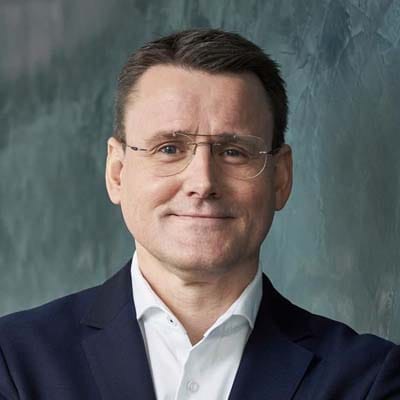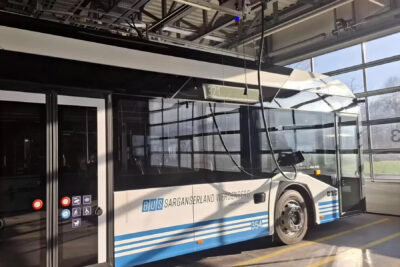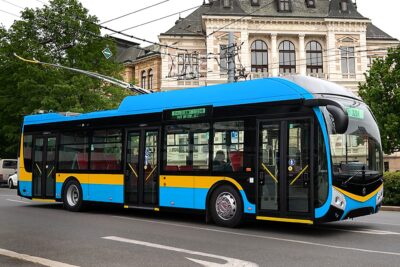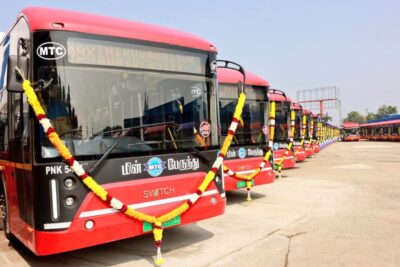
“Openness to technology is not industrial policy” – interview with MAN CEO Alexander Vlaskamp
Alexander Vlaskamp visited the German Chancellery recently. Together with Karin Rådström, CEO of Daimler Truck, the MAN CEO represented commercial vehicle manufacturers at the latest auto summit. A selfie shows the top executives on their mission. Normally competitors, but united in the drive transition? Vlaskamp confirms that in the industry, everyone essentially wants the same things. That is no surprise, given the immense challenges.
Yet Vlaskamp is forward-looking and clear: he reacts impatiently to the whole debate about openness to technology. Because: “It is not a long-term industrial policy.” In his view, the battery-electric share of road freight transport in Europe could exceed 90 per cent in the future – if everyone gets on the same page and understands that we are currently in a critical phase. Vlaskamp considers the situation serious. The electrification of the commercial vehicle industry is still in its infancy. It is not self-running. In an interview with electrive, the MAN CEO warns that the development is moving far too slowly at present.
Mr Vlaskamp, you attended the auto summit at the German Chancellery. Looking at the commercial vehicle industry as a whole, how big are the differences in interests within your sector?
In the commercial vehicle industry, differences in interests are not particularly large. Essentially, the entire industry assumes that the majority of future truck transport will be electrically powered. There are only small differences in the strategies of individual companies. These differences are mostly about percentages and assessments of the pace of this development.
When you hear the words “openness to technology”, what comes to mind?
We are an industrial company, and by our DNA, we are “open to technology”. However, you have to recognise that there is currently very clear technological clarity. We assume that the battery-electric share of road freight transport in Europe will exceed 90 per cent in the future. The products exist and can be ordered. And they are very good. Battery-electric drive will therefore prevail in a cost-driven industry. The challenges come from the (right) societal expectation to accelerate this ramp-up extremely quickly. Of course, it is always easier to highlight the challenges of a new technology than to create the framework conditions for it. This “openness to technology” must not make electric mobility appear unready for the market, slowed down, or disadvantaged.
It feels as though we have already reached consensus on the technological future of commercial vehicles. Now the pendulum seems to be swinging back – do you share that impression?
No, one must distinguish between agreement on the technological future and assessments of how quickly this future should be reached, and who must bear the risk of not achieving it. Our industry has delivered: we have done our homework and developed very good products. Unfortunately, implementing the promised framework conditions, for example, regarding charging infrastructure, is taking longer than perhaps expected. This is not in our hands. Yet we are supposed to bear the risk, keyword penalties. That doesn’t add up: the whole debate about openness to technology is therefore not a long-term industrial policy.
Can multiple technology paths be developed in parallel? The German Chancellor seems to imagine this and even invites the industry to do so. Your competitor from Stuttgart does not want to abandon the fuel cell either. How is MAN proceeding?
Of course, we keep various drive technologies in view and will continue to pursue them to differing extents, as we have done for decades. Unlike Daimler, we already offer a hydrogen combustion engine that can be ordered today. We are also continuing to develop the fuel cell. But it is also clear that there is currently little market demand for such solutions due to the high price of hydrogen. And this will not change in the foreseeable future. Currently, hydrogen costs up to €20 per kilo. Our vehicles become profitable only at a price between €3 and €5. That is a long way off. Our technology decisions, as in the past, are ultimately based on technological maturity, availability, and cost. Here, the electric truck is simply years ahead of hydrogen.
A recent ICCT study showed that most European truck manufacturers are on track to meet the 2025 EU fleet targets. In your case, Scania saves Traton’s balance sheet, as MAN still has room for improvement. How do you assess the situation this year?
With our currently even more efficient engines and our present share of e-mobility, we are already on a good path. In e-mobility, we have the highest growth rates in the entire group, and we recently surpassed the 1,000-unit mark for the first time with our e-buses and e-trucks. And we are still at the very beginning of the ramp-up. Good development does not mean we can now rest. The commercial vehicle market is under considerable pressure due to the economic situation. Investments in the drive transition by our customers are therefore not automatic. We aim to convince them with a good product, but for this, we need further ramp-up of charging infrastructure across Europe, especially network access at logistics depots.
And why will meeting the EU CO₂ targets up to 2030 be so much harder from your perspective?
By 2030, and especially from 2030 onwards, we must achieve a new approval quota, i.e., a 45 per cent CO₂ reduction. That is an ambitious leap for which we have only a few years. It requires a significantly expanded charging infrastructure across all EU member states, both in public spaces and depots. Currently, development is being slowed by bureaucratic hurdles and, in particular, by missing network connections. Without sufficient charging infrastructure in depots and public areas, the necessary step from 2030 will not be achievable – beyond our control as manufacturers.
What are your main demands from policymakers in Brussels and Berlin? What about subsidies? Will Berlin do more to help the commercial vehicle sector, or is the toll exemption enough?
The most important demand is to suspend the planned penalties for 2030 and, where possible, link them to framework conditions over which we have no direct influence. In short: we need more flexibility in CO₂ regulation. There also needs to be a clear political commitment to electrifying the commercial vehicle sector – not solely at the industry’s risk, but with concrete steps, such as including hauliers and logistics companies in Section 9b of the Electricity Tax Act. Logistics companies will become energy-intensive operators, especially if the framework for bidirectional charging improves. This reality must also be reflected politically and fiscally. Moreover, targeted support for infrastructure and vehicles, especially for small and medium-sized enterprises (SMEs), is crucial to ease high initial investments.
Why do you highlight the SME segment in trucking?
Around 80 per cent of transport companies are SMEs. They do not cover 80 per cent of transport volume, but they form the backbone of the industry. For these companies, initial investment is difficult, even with advantageous operating costs. They rarely benefit from special tax depreciation. That is why targeted support is essential. Moreover, we need a strong acceleration of network expansion. Electrification cannot fail due to network connections, while political efforts to accelerate this side remain insufficient. Overall, the total operating costs of battery-electric vehicles must be lower than diesel vehicles’ to make the switch economically feasible and sustainable. Our customers and we therefore need political reliability and long-term planning certainty. That is the transport and industrial policy I expect, and that gives us the strength to compete with new market entrants.
Speaking of new competitors: Sany will bring a BEV truck to Europe for the first time in early 2026. In the e-bus sector, Chinese brands have already been competitive for some time. How do you plan to compete with these new rivals?
Electrification is the major transformation of our industry and is in full swing. The drive transition is thus not just an important climate policy tool, but above all a means to secure the competitiveness of the European commercial vehicle industry against new rivals from the Far East, who focus on battery-electric drives. Autonomous driving represents an even greater transformation. At MAN, we are well prepared for this next step. In our ATLAS L4 project, we have demonstrated that we can technically manage hub-to-hub autonomous transport under current European laws. From 2030, we plan to offer the first autonomous series solutions.
Can an OEM still afford to be only an OEM in the future? How far can manufacturers go, for example, in installing public chargers?
As the Traton Group, together with Daimler and Volvo, we have invested in the Milence joint venture. Milence aims to establish 1,700 charging points at public locations by 2027. The goal is to provide the urgently needed charging infrastructure for the ramp-up of e-mobility in commercial vehicles. We also have a comprehensive partnership with E.ON to build publicly accessible chargers at our service locations. This commitment is a crucial step in realistically achieving ambitious CO₂ targets from 2030. It shows that industry is ready to take responsibility.
Now politics must provide the right framework – for example, simplified approval processes, sufficient network capacity, and support instruments for operators, especially SMEs. Only in cooperation with politics can the ramp-up of e-mobility in transport succeed quickly.
Our product range has evolved significantly. We offer customers 360° consultancy, covering all aspects of electrifying an individual fleet. With the transition to software-defined vehicles and autonomous vehicles, our role will continue to evolve.
Regarding your company: hardly any OEM seeks as many synergies between electric buses and electric trucks as MAN. Is this a real competitive advantage or born of necessity?
It is a real competitive advantage! We invested early in our own battery development and production. We invested €250 million in our Nuremberg plant alone. Over €1 billion has gone into our electric vehicle portfolio. Now it pays off! Our battery families for buses and trucks have high synergies while being optimally designed for their specific application.
Form factor, number of batteries, power, integration into the vehicle – all oriented to maximise customer utility! Thanks to this philosophy, we can offer a fully electric Low-Liner tractor: low cab height for maximum loading volume, shortest wheelbase, and maximum battery capacity. Perfect for automotive logistics and unique on the market! With the same in-house expertise, we recently presented the first fully electric coach with up to 650 km range at Busworld Brussels. The high synergies across products are a huge advantage.
Several competitors switched from NMC to LFP batteries. MAN did not. Why?
NMC offers higher energy density, meaning batteries occupy less space and are lighter for the same or greater range. It also supports our modular design approach, where customers can choose between three and seven batteries depending on use, range, and payload. NMC batteries also charge better in cold temperatures. These are strong arguments for commercial vehicles. Naturally, we monitor battery technology closely and continuously assess pros and cons in product development. Ultimately, it is about customer utility at competitive costs.
Finally, a look into the crystal ball: where will MAN be with electrification in five years?
It depends on the framework conditions. If it were up to us, by 2030 around 50 per cent of our new registrations in Europe will be electric.
Mr Vlaskamp, thank you very much!





1 Comment